78 - Benign and Malignant Tumors of the Trachea
Editors: Shields, Thomas W.; LoCicero, Joseph; Ponn, Ronald B.; Rusch, Valerie W.
Title: General Thoracic Surgery, 6th Edition
Copyright 2005 Lippincott Williams & Wilkins
> Table of Contents > Volume I - The Lung, Pleura, Diaphragm, and Chest Wall > Section XIV - Congenital, Structural, and Inflammatory Diseases of the Lung > Chapter 92 - Pulmonary Paragonimiasis and Its Surgical Complications
Chapter 92
Pulmonary Paragonimiasis and Its Surgical Complications
Hiroshi Mukae
Fukumi Nakamura-Uchiyama
Yufigumi Nawa
Paragonimiasis is a subacute to chronic inflammatory disease of the lung caused by lung flukes of the genus Paragonimus. Paragonimiasis is a food-borne parasitic disease common in East Asia, particularly in Japan, Korea, China, Taiwan, and the Philippines. A high incidence of paragonimiasis is also observed in some parts of Africa and Latin America. It rarely occurs naturally in the United States, and patients identified in North America have mostly been emigrants or refugees from endemic areas, as reported by Johnson and Johnson (1983) and Taylor and Swett (1982). Blair and co-workers (1999) noted that among the over 40 species of genus Paragonimus described to date, Paragonimus westermani is the most frequent etiologic agent, which infects millions of people throughout Asia. Several other species, including P. miyazakii, P. uterobilateralis, P. africanus, P. mexicanus, and P. kellicotti, also cause pulmonary disease. Paragonimiasis is closely related to eating habits. Infection results from ingestion of raw or inadequately cooked freshwater crabs and crayfish, which are intermediate hosts for the organism. According to Miyazaki and Hirose (1976), raw flesh of crab-eating mammals like wild boars can also be a source of the paratenic human infection, and this mode of infection appears to be increasing in Japan, as reported by two of us (FNU and YN) and a colleague (1999). Paragonimiasis is rarely seen in Europe and North America, but one patient was reported who appeared to be infected while visiting Japan by Guiard-Schmid and associates (1998). Meehan and colleagues (2002) also reported that a patient with paragonimiasis who had resided only in the northcentral United States for 8 years, habitually ate pickled or frozen crabmeat that was imported from Southeast Asia. These findings suggest that the disease will be encountered more frequently in various parts of the world in the future due to popularization of oriental dishes and increasing international travel. Of note is that P. kellicotti exists in parts of the midwestern and eastern United States as reported by Ameel (1934). However, human infection in the United States is rare because the ingestion of raw freshwater crab or crayfish does not commonly occur. However, recently De Frain and Hooker (2002) reported one case of paragonimiasis that developed in an 18-year-old man after the ingestion of raw freshwater crayfish while on a camping trip in northern Michigan. Procop and associates (2000) also reported a case in a patient with no history of foreign travel or ingestion of foreign foods.
ETIOLOGY
Life Cycle of Paragonimus
Paragonimus is a highly adapted organism that reproduces through a complex life cycle. The definitive host harbors the adult worm in the lung, where it produces eggs that are voided from the host in sputum. Eggs are frequently swallowed and are often present in the feces. Under suitable conditions, eggs lying in moist soil or water hatch as miracidiae that infest the first intermediate host, freshwater snails. In the snail, miracidiae develop into cercariae, which subsequently invade freshwater crabs or crayfish, the second intermediate hosts, where they develop into metacercariae, an infective form. Infection of the final host occurs by eating the flesh of raw crayfish or freshwater crabs contaminated with the metacercariae. Handling the raw flesh or juice may also result in transfer of metacercariae from the hand into the mouth. When freshwater crabs or crayfish contaminated with the metacercariae are ingested by unsuitable mammalian hosts such as wild pigs and boars, juvenile worms excysted from metacercariae migrate into the muscles of the hosts, where they can remain in an immature state for many years, as reported by Miyazaki and Hirose (1976).
Migration in the Definitive Host
A typical route of migration of P. westermani in humans or other natural final hosts is as follows (Fig. 92-1). When
P.1310
metacercariae are ingested by the final host, they excyst in the intestine, penetrate into the abdominal cavity, and then reside in the abdominal muscles for about a week. Then the larvae migrate through the peritoneum, liver, and diaphragm, and into the pleural space. Here, they penetrate the lungs where they finally become mature adult flukes. This migration process takes several weeks. They commence laying eggs in the lungs and can live there for many years. The life cycle of the parasite is complete when eggs are returned to the environment to repeat the process. On some occasions the worms accidentally migrate into other sites, such as subcutaneous tissue, liver, and brain (extrapulmonary paragonimiasis).
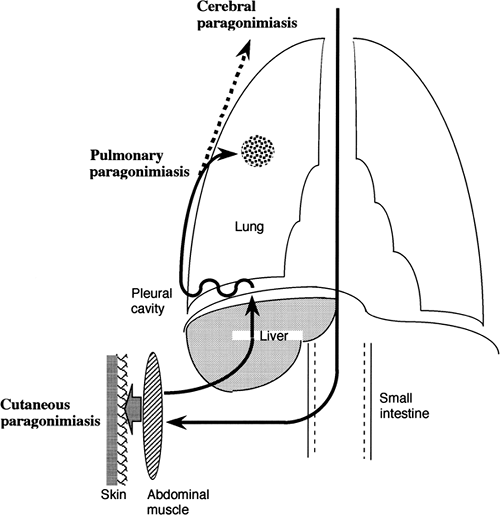 |
Fig. 92-1. Migration route of Paragonimus in humans. Paragonimiasis patients express various symptoms depending on the location of the worms. From Nakamura-Uchiyama F, Mukae H, Nawa Y: Paragonimiasis: a Japanese perspective. Clin Chest Med 23:409, 2002. With permission. |
CLINICAL FEATURES
Clinically, symptoms related to paragonimiasis parallel the migration and maturation of the parasite. According to Tokojima and colleagues (2001), patients with pulmonary paragonimiasis exhibit primarily respiratory symptoms, including cough (70%), hemoptysis (reddish brown-colored sputum, 35%), chest pain (35%), and dyspnea (17%). Other symptoms, such as low-grade fever (22%), subcutaneous tumors (9%), diarrhea (4%), abdominal pain (4%), and weight loss (4%), are also reported. Although clinical findings depend on the worm load, patients usually maintain a better state of general health than what is predicted from their chest radiographs. Few signs are observed on physical examination, although some patients can have audible crepitations in the chest. In cases of cutaneous paragonimiasis, a slow-moving, nodular lesion in the subcutaneous tissue of the abdominal or anterior chest wall is characteristic. Paragonimiasis in the brain can be fatal, and can cause epileptic seizures, hemiplegia, and encephalitis. For clinical diagnosis, the patient's history, including eating habits, is usually more important than the physical examination.
Peripheral blood eosinophilia and elevated serum immunoglobulin E (IgE) are observed in patients with paragonimiasis, as in other helminth parasite infections, but the total white blood cell count usually remains in the normal range or only slightly elevated. Two of us (FNU and YN) and an associate (2001) recently reported that the degree of peripheral blood eosinophilia was slightly higher in patients with pleurisy compared with patients who have intrapulmonary lesions. Tokojima and co-workers (2001) reported that peripheral blood eosinophilia was seen only in 56.5% of patients with pulmonary paragonimiasis. Thus, at least some patients, especially those with only parenchymatous lesions, may have a normal peripheral eosinophil count. Lack of eosinophilia, therefore, should not be used to exclude the possibility of Paragonimus infection. However, a
P.1311
marked eosinophilia is commonly seen in samples from affected lesions like pleural effusion and bronchoalveolar lavage fluid (BALF), as reported previously by one of us (HM) and associates (2001a). Two of us (FNU and YN) and a colleague (2001) noted that the total serum IgE level, which is also an important parameter for parasitic diseases, has no correlation with the stage of paragonimiasis. Other laboratory tests appear to be of little diagnostic value.
Paragonimiasis can produce a range of different radiographic images. According to us (FNU, HM, and YN) (2002), intrapulmonary lesions in paragonimiasis can be roughly classified as nodular (Fig. 92-2A,B,C), infiltrative (Figs. 92-2D and 92-3A),
P.1312
cavitating shadows (Fig. 92-3B), or a combination. Ogakwu and Nwokolo (1973) described four patterns: the most common shadows were well-defined patches of cavitation, ill-defined cotton wool lesions, streaky shadows, or bubble cavities. These patterns were identified predominantly in the midzones of the lungs. In their study, normal chest radiographs were also observed in approximately 20% of patients in whom Paragonimus eggs were identified. However, a somewhat different radiologic presentation was observed by Johnson and Johnson (1983), who described diffuse (44%) and segmental (24%) infiltrates, nodules (20%), and cavities (20%). Cavitating lesions in chest radiographs are sometimes described as ring shadows, which were the most prominent lesion in a study of 38 cases in Thailand by Suwanik and Harinsuta (1959). Im and colleagues (1992) emphasized that air space consolidation with or without cystic changes were the most common findings in Korea. In a recent experience in Japan of one of us (HM) and colleagues (2001a), the most common lesion was a nodular shadow (see Fig. 92-2), a pattern distinct from those observed in the aforementioned studies. In addition, chest computed tomographic (CT) scans revealed that the nodules were frequently located near bronchioles or bronchi, predominantly in the subpleural region and occasionally accompanied by ectatic changes in associated bronchi. Atelectasis is observed less frequently, because of the compression by the massive pleural effusion or bronchial stenosis. Mediastinal lymphadenopathy is also occasionally seen. On chest radiography, the differential diagnosis of pulmonary paragonimiasis should therefore include lung cancer, tuberculosis, and fungal infection. In this context, Johnson and Johnson (1983) noted that 68% of their patients with paragonimiasis had been treated erroneously for pulmonary tuberculosis. Yoshino and colleagues (1998) reported a case of a patient in whom P. westermani infection was diagnosed after an open lung biopsy was performed for a suspected lung cancer, following normal routine laboratory examination results and the absence of any clinical symptoms. Tomita and associates (2000) likewise reported six patients who were referred to the department of surgery because of having a mass lesion on chest radiography that was indistinguishable from malignancy. Pleural lesions such as pleural effusion or pneumothorax are also often observed in infected patients. Johnson and Johnson (1983) noted that 48% of patients had pleural effusions. We (FNU) (2001) and (HM) (2001a) and our co-workers likewise noted that nearly 70% of patients with paragonimiasis present with pleural lesions in Japan. Similarly, 61% of Korean patients develop pleural lesions in their clinical course, as reported by Im and colleagues (1992). Because Paragonimus worms pass through the pleural cavity before they reach the lungs, a high incidence of pleural lesions is not surprising. One of us (HM) and associates (2001a) have previously reported that some patients showed typical clinical features of paragonimiasis with transient pleurisy followed by parenchymal lesions several months later, which was consistent with the migratory route.
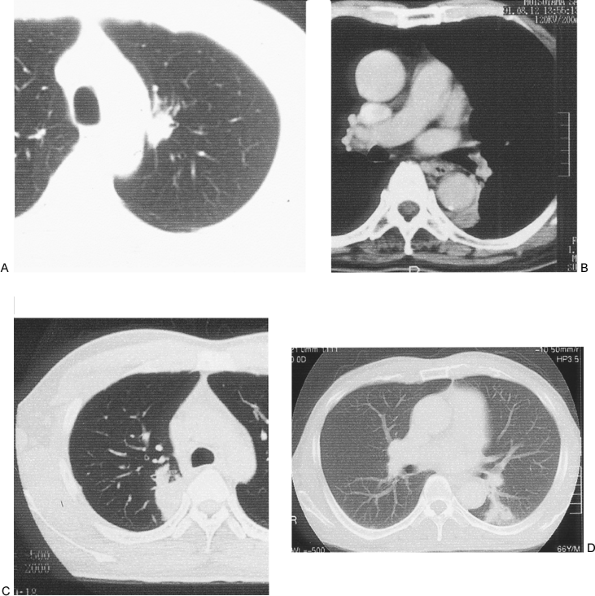 |
Fig. 92-2. A. A chest computed tomographic (CT) scan of a 41-year-old man who complained of cough and hemosputum, showing a subpleural nodular opacity in the left upper lobe. The diagnosis of paragonimiasis was made by detection of ova in a bronchoscopic washing. B. A chest CT scan of a 77-year-old man showing a well-defined subpleural nodule in the left lower lobe. C. A chest CT scan of a 25-year-old man showing a well-defined subpleural module in the right upper lobe. D. A chest CT scan of a 66-year-old man who complained of cough and hemosputum, showing a poorly defined consolidation in the left lower lobe. He reported often eating the flesh of wild boars. The diagnosis of paragonimiasis was confirmed by sputum examination, which demonstrated ova. |
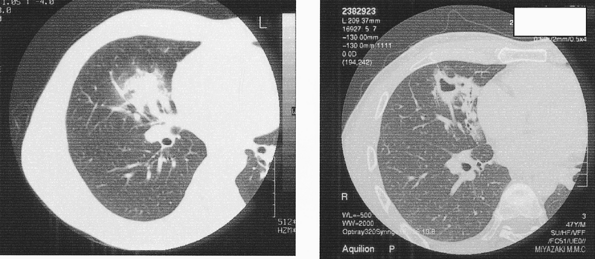 |
Fig. 92-3. A. Chest CT scan of a 74-year-old man who complained of cough and hemosputum, who was diagnosed with paragonimiasis by immunodiagnosis, showing a poorly defined consolidation in the right middle lobe. B. Two months later, cavity formation was observed in this lesion. |
DIAGNOSIS
Diagnosis of paragonimiasis is based primarily on the patient's history, including travel or residence in endemic areas and eating habits. A definitive diagnosis can be made by identifying the typical operculated eggs in sputum, stools, or pleural fluid. Currently in Japan, the egg detection
P.1313
rate in sputum, stools, or pleural effusions is very low, but cytologic examination of bronchial brushing or BALF can raise the egg detection rate, as reported by one of us (HM) and colleagues (2001a) (Fig. 92-4). Histologically, bronchial stenosis with congested and edematous mucosa is also seen on bronchoscopic examination in the majority of patients with intrapulmonary lesions. The low detection rate of eggs in sputum, stool, or pleural effusion in Japan may be due to an increasing number of lightly infested patients. In such patients who test egg negative in sputum and feces, immunologic tests are particularly useful.
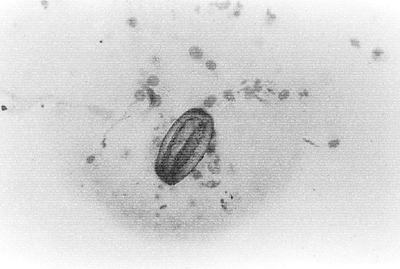 |
Fig. 92-4. A Paragonimus westermani egg isolated by bronchial brushing. |
Various immunologic methods have been developed for the diagnosis of paragonimiasis. Classical methods, such as the intradermal test, have gradually been replaced by more sensitive and specific methods such as the enzyme-linked immunosorbent assay (ELISA), because the intradermal test can remain positive for many years after recovery. Slemenda and colleagues (1988) also developed an immunoblot assay, which is highly accurate in diagnosing paragonimiasis. However, the intradermal test is still used for epidemiologic surveys in endemic areas because it is simple, cheap, and rarely yields false-negative reactions. Various modified ELISA methods have been developed for different purposes. Although crude worm extracts were initially used as antigens for ELISA, cross-reactions with other trematode infections decreased the reliability of this diagnostic method. Therefore, ELISA systems using purified antigens have also being established to increase the sensitivity of this detection method. Kim and co-workers (2002) recently reported that ELISA using recombinant P. westermani yolk ferritin had 88.2% sensitivity and 100% specificity with the limitation that this method is not applicable to the migratory stage of infection. A simple screening kit, which is not very specific but covers a broad range of parasitic diseases, is also necessary at the first step of differential diagnosis, as it is important for clinicians to recognize at the outset whether patients have a parasitic disease or not. Itoh and Sato (1990) and Maruyama and associates (1996) developed the multiple-dot ELISA method for this purpose. In this system, a panel of various parasite antigen solutions is dotted on a strip of nitrocellulose membrane to detect a specific antibody in the patient's serum and body fluid. Advantages of this method are that results can be obtained within 2 to 3 hours and analysis of results can be conducted by simply scoring the color density of each spot. To monitor the clinical course of an individual patient or to evaluate the efficacy of treatment, quantitative measurement of parasite-specific IgG antibody by a microplate ELISA method should be used. Although most ELISA systems were developed for the diagnosis for paragonimiasis to detect parasite-specific IgG antibody, two of us (FNU and YN) (2001) and the first author (HM) (2001b) and our colleagues have recently found that detection of parasite-specific IgM antibody is important for the diagnosis of paragonimiasis, especially in the early stage of the disease.
CURRENT MEDICAL THERAPY
Praziquantel is currently the first choice for treatment of paragonimiasis because of its effectiveness, short duration of treatment, commercial availability, and only mild and transient adverse effects, such as headache, nausea, and urticaria, as reported by Johnson and colleagues (1985) and Rim and Chang (1980). Although the manufacturer's recommended dose of praziquantel is 40 mg/kg/day, Rim and Chang (1980) recommended 75 mg/kg/day for 2 to 3 days to obtain a 100% cure. Treatment with this drug usually clears the chest radiograph, and symptoms disappear within 1 to 2 months. Patients infected with various Paragonimus species have been treated successfully with this drug. When patients are treated with insufficient doses, the cure rate decreases significantly. One of us (HM) and associates (2001a) found that following treatment, ectatic changes can occur in the associated bronchi in patients with intrapulmonary paragonimiasis, and pleural thickening, passive atelectasis, or empyema in patients with pleurisy. Therefore, early diagnosis and treatment with a full dose of praziquantel is necessary to eradicate paragonimiasis. Praziquantel is also effective for treatment of cutaneous, cerebral, or any other form of extrapulmonary paragonimiasis. Bithionol was the first drug identified to be highly effective for chemotherapy of paragonimiasis, as Yokogawa and colleagues (1963) noted. Due to the requirement for long-term administration and moderate to severe side effects, such as nausea or diarrhea, bithionol has gradually been replaced by praziquantel. Bithionol is no longer available because its production has been stopped. Triclabendazole, a new benzimidazole derivative used for treatment of fascioliasis, also has a parasiticidal effect on Paragonimus worms, as reported by Weber and associates (1988). A clinical trial by Calvopina and colleagues (1998) also showed that triclabendazole was as effective as praziquantel in clearing infections with better toleration. However, recently we are conducting a small-scale trial of triclabendazole treatment for paragonimiasis westermani patients in Japan, and the results are not quite satisfactory
P.1314
compared with the previous reports. This might be due to species difference, and an additional large-scale trial is required to reach definitive evaluation of the efficacy of this drug for the treatment of paragonimiasis.
Because rapid and reliable immunodiagnostic methods are now available and chemotherapy with praziquantel is quite successful in paragonimiasis, unnecessary admission under suspicion of malignancy or tuberculosis (TB), or invasive examination or treatments with surgical approaches, should be avoided.
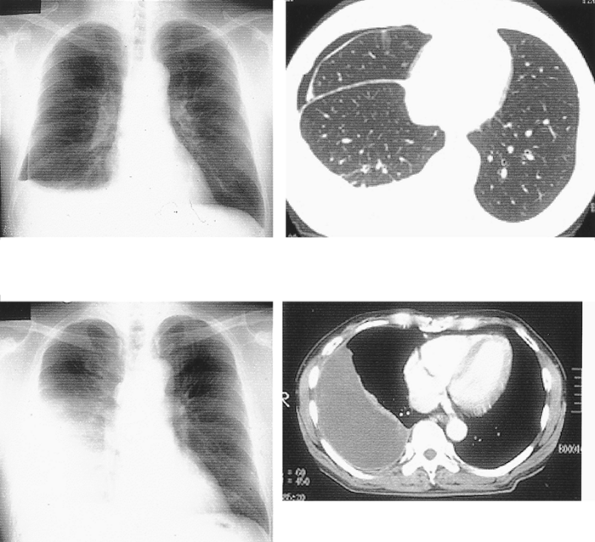 |
Fig. 92-5. Pleural paragonimiasis. Chest radiograph (A) and CT scan (B) of a 41-year-old man showing right pleural effusion and pneumothorax. Chest radiograph (C) and CT scan (D) of a 57-year-old man with chronic pleural empyema caused by P. westermani infection showing massive pleural effusion surrounded by thickened pleura. This patient was resistant to repeated chemotherapy and required surgical decortication. From Nakamura-Uchiyama F, Mukae H, Nawa Y: Paragonimiasis: a Japanese perspective. Clin Chest Med 23:409, 2002. With permission. |
REQUIREMENT OF SURGICAL TREATMENT FOR PARAGONIMIASIS
Most of patients with paragonimiasis can be cured completely by drug treatment, so surgeons should be aware of the possibility of paragonimiasis when a pulmonary mass lesion is detected in patients who have traveled or live in the endemic areas. Surgical intervention is often required to achieve cure in some cases with pneumothorax, pleural effusion, pleural empyema, and, rarely, pericardial effusion.
P.1315
Pneumothorax and Pleural Effusion
During the process of pleural penetration by juvenile worms, pneumothorax or pleural effusion may occur. According to Im and colleagues (1992), pleural effusions occur more frequently than pneumothorax. One of us (HM) and associates (2001a) reported that even patients with intrapulmonary paragonimiasis sometimes have pleural effusions or local chronic pleural thickness on chest radiographs and CT scans. In endemic areas, therefore, identification of Paragonimus eggs and immunodiagnosis of Paragonimus using fluid obtained via thoracocentesis are needed, especially in patients with pleural effusion with peripheral eosinophilia. As noted by Taniguchi (2001) and Matsumoto (2002) and colleagues, marked eosinophilia (>60%), which parallels levels of interleukin-5, and thymus- and activation-regulated chemokine in the pleural effusion, are characteristic in pleural paragonimiasis. The effusion comprises an exudate with low glucose, and elevated levels of lactate dehydrogenase (average ~3,000 U/L) and total protein (average ~6.5 g/dL), and therefore testing these values may be helpful. Pneumothorax is uncommon, but occurs simultaneously with pleural effusion (Fig. 92-5A,B). Pneumothorax has been reported in 17% of cases by Im and colleagues (1992) and 15% of patients by one of us (HM) and associates (2001a). Small pneumothoraces and pleural effusions probably occur often, but resolve spontaneously without diagnosis. However, some patients require drainage via an intercostal tube because of massive retention of pleural fluid. Extensive drainage of the pleural effusion prior to starting chemotherapy is important in patients with pleural effusion because insufficient drainage and delayed diagnosis often results in complicated conditions, such as chronic pleural empyema or insufficient lung inflation.
P.1316
Pericardial effusion is rare, but can also occur in Paragonimus infection. It appears to be transient, and treatment with praziquantel is effective, as reported by Saborio (1995) and one of us (HM) (2001a) and our colleagues.
 |
Fig. 92-6. A. Chest radiograph of a 19-year-old man with Paragonimus empyema, taken before admission, shows massive empyema causing almost complete white-out of the left thorax. B. Bronchogram 13 days later reveals complete collapse of the left lung with cutoff of all major bronchi. Note diminution of the left thorax with scoliosis. C. Two months later, shortly after left decortication. D. Chest radiograph 5 years after decortication shows excellent result. Note regeneration of sixth rib, slight elevation of left diaphragm laterally, and disappearance of scoliosis. |
Empyema
Dietrick and colleagues (1981) reported 58 cases of chronic pleural empyema in Korea that were managed successfully by decortication, and 16 of the 58 were complications of P. westermani infection. Empyema has also been reported as a complication of Paragonimus by Ogakwu and Nwokolo (1973) as well as by Tomita and colleagues (1996) and DeFrain and Hooker (2002) (Fig. 92-5C,D). Empyema is thus a rare, but important complication of this condition. Dietrick and colleagues (1981) noted that empyema associated with Paragonimus infection usually develops more slowly, tends to form fewer fistulae, and has a better prognosis than empyema associated with tuberculosis. In some cases, no worms or eggs are detected in the pleural effusion or thickened pleural tissues. In addition, eosinophilia is not always evident in the pleural effusion. The mean duration of symptoms preceding operative intervention, including decortication, was over 6.5 years in Paragonimus infection, significantly longer than in patients with tuberculosis. Such chronicity may make the association difficult to detect, so immunodiagnosis may be useful. In early empyema caused by Paragonimus infection, medical treatment together with a chest drainage may be sufficient for cure. However, chronic cases, as described by Tomita (1996) and Dietrick (1981) and associates, may be resistant to repeated chemotherapy with drugs such as praziquantel and bithionol, and therefore decortication with reexpansion of the lung may be necessary (Fig. 92-6). Dietrick and associates (1981) emphasized that both the parietal and visceral pleural surfaces should be removed; the surface is often surprisingly thick but easy to remove. Decortication is therefore often easier in paragonimiasis empyema than in tuberculous empyema, and the results are correspondingly better.
REFERENCES
Ameel DJ: Paragonimus, its life history and distribution in North America and taxonomy (Trematoda: Troglotrematidae). Am J Hyg 19:279, 1934.
Blair D, Xu ZB, Agatsuma T: Paragonimiasis and the genus Paragonimus. Adv Parasitol 42:113, 1999.
Calvopina M, et al: Treatment of human pulmonary paragonimiasis with Triclabendazole: clinical tolerance and drug efficacy. Trans R Soc Trop Med Hyg 92:566, 1998.
DeFrain M, Hooker R: North American paragonimiasis: case report of a severe clinical infection. Chest 121:1368, 2002.
Dietrick RB, Sade RM, Pak JS: Results of decortication in chronic empyema with special reference to paragonimiasis. J Thorac Cardiovasc Surg 82:58, 1981.
Guiard-Schmid JB, et al: Paragonimiasis: a rare infection in Europe. Presse Med 27:1835, 1998 (in French with English abstract).
Im J-G, et al: Pleuropulmonary paragonimiasis: radiologic findings in 71 patients. AJR Am J Roentgenol 159:39, 1992.
Itoh M, Sato S: Multi-dot enzyme-linked immunosorbent assay for serodiagnosis of trematodiasis. Southeast Asian J Trop Med Pub Health 21: 471, 1990.
Johnson RJ, Johnson JR: Paragonimiasis in Indochinese refugees: roentgenographic findings with clinical correlations. Am Rev Respir Dis 128:534, 1983.
Johnson RJ, et al: Paragonimiasis: diagnosis and the use of praziquantel in treatment. Rev Infect Dis 7:200, 1985.
Kim TY, et al: Recombinant Paragonimus westermani yolk ferritin is a useful serodiagnostic antigen. J Infect Dis 185:1373, 2002.
Maruyama H, Noda S, Nawa Y: Emerging problems of parasitic diseases in southern Kyusyu, Japan. Jpn J Parasitol 45:192, 1996.
Matsumoto N, et al: Elevated levels of thymus and activation-regulated chemokine (TARC) in pleural effusion samples from patients infested with Paragonimus westermani. Clin Exp Immunol 130:314. 2002.
Meehan AM, et al: Severe pleuropulmonary paragonimiasis 8 years after emigration from a region of endemicity. Clin Infect Dis 35:87, 2002.
Miyazaki I, Hirose H: Immature lung flukes first found in the muscle of the wild boar in Japan. J Parasitol 62:836, 1976.
Mukae H, et al: Clinicoradiologic features of pleuropulmonary Paragonimus westermani on Kyushu Island, Japan. Chest 120:514, 2001a.
Mukae H, et al: Case report: Paragonimiasis westermani with seroconversion from immunoglobulin (Ig) M to IgG antibody with the clinical course. Am J Trop Med Hyg 65:837, 2001b.
Nakamura-Uchiyama F, Mukae H, Nawa Y: Paragonimiasis: a Japanese perspective. Clin Chest Med 23:409, 2002.
Nakamura-Uchiyama F, Onah DN, Nawa Y: Clinical features of paragonimiasis cases recently found in Japan: parasite-specific immunoglobulin M and G antibody classes. Clin Infect Dis 32:e171, 2001
Ogakwu M, Nwokolo C: Radiological findings in pulmonary paragonimiasis as seen in Nigeria: a review based on one hundred cases. Br J Radiol 46:699,1973.
Procop GW, et al: North American paragonimiasis: a case report. Acta Cytol 44:75, 2000.
Rim HJ, Chang YS: Chemotherapeutic effect of niclofolan and praziquantel in the treatment of paragonimiasis. Korea Univ Med J 17:113, 1980. (In Korean with English abstract.
Saborio P, et al: Paragonimus mexicanus pericarditis: report of two cases and review of the literature. J Trop Med Hyg 98:316, 1995.
Slemenda SB, et al: Diagnosis of paragonimiasis by immunoblot. Am J Trop Med Hyg 39:469, 1988.
Suwanik R, Harinsuta C: Pulmonary paragonimiasis: an evaluation of roentgen findings in 38 positive sputum patients in an endemic area in Thailand. AJR 81:236, 1959.
Taniguchi H, et al: Elevated IL-5 levels in pleural fluid of patients with Paragonimiasis westermani. Clin Exp Immunol 123:94, 2001.
Taylor CR, Swett HA: Pulmonary paragonimiasis in Laotian refugees. Radiology 143:411, 1982.
Tokojima M, et al: Clinical features in twenty-three patients with Paragonimiasis westermani. Nihon Kokyuki Gakkai Zasshi 39:910, 2001. (In Japanese with English abstract.)
Tomita M, et al: A case of chronic pleural empyema by Paragonimus westermani infection resistant to chemotherapy and cured by surgical decortication. Jpn J Parasitol 45:242, 1996.
Tomita M, et al: Pulmonary paragonimiasis referred to the department of surgery. Ann Thorac Cardiovasc Surg 6:295, 2000.
Uchiyama F, Morimoto Y, Nawa Y: Re-emergence of paragonimiasis in Kyusyu, Japan. Southeast Asian J Trop Med Public Health 30:686, 1999.
Weber P, Buscher G, Buttner DW: The effects of Triclabendazole on the lung fluke, Paragonimus uterobilateralis in the experimental host Sigmodon hispidus. Trop Med Parasit 39:322, 1988.
Yokogawa M, et al: Chemotherapy of paragonimiasis with bithionol. V. Studies on the minimum effective dose and changes in abnormal X-ray shadows in the chest after treatment. Am J Trop Med Hyg 12:859, 1963.
Yoshino I, et al: Paragonimiasis westermani presenting as an asymptomatic nodular lesion in the lung: report of a case. Surg Today 28:108, 1998.
EAN: 2147483647
Pages: 203